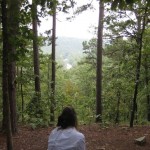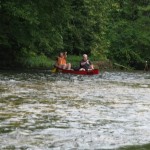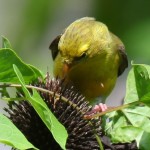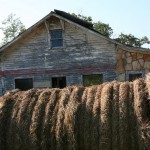
Riveroflife
Posts by :

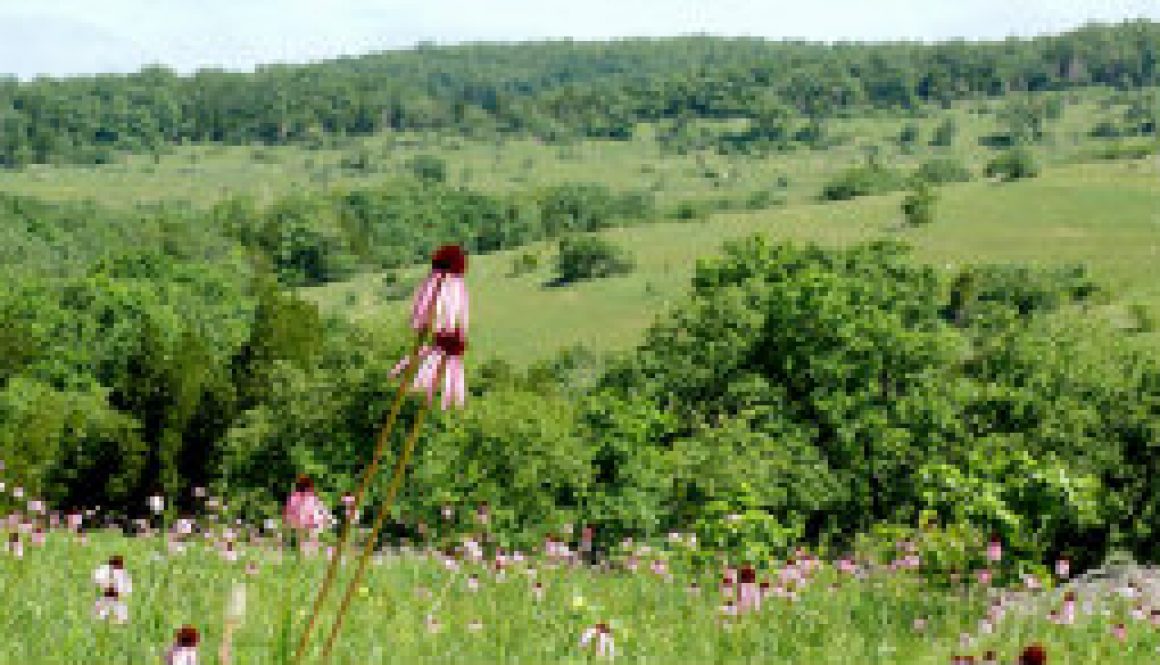
Floating the North Fork in the mid-1960’s PART Two of Five

We were wakened at dawn by birds signing everywhere; got up quickly, checked the time and had a small breakfast, and impatiently waited for the farmer to arrive. Sure enough a 6:30 AM, exactly, we heard a gate swing open and there he was.
Then ride to the put-in point a little under five miles upstream was, even to my thinking at the time, through some real Ozark back country, There were still a dozen log cabins along the road, many from prior to the tune of the century; some neatly dovetailed; and some falling down. The road the narrow and only qualified as an improved dirt road running through hayfields. Only a few stands of tress could be seen here and there. In what seemed like an hour, the farmer got out and opened a farm gate on the right and we turned in, I jumped out and closed the gate. We rambled through the pasture and down to a clump of trees in a fairly shallow valley. The clump of trees was like and oasis with a large spring issuing from under a ledge rock and dumping into a small, clear stream. The stream was no more than 6-8 feet wide but ran clear and swift. This was the headwaters of the North Fork River. Upstream, was clearly visible, a large hayfield, with a low mudbank on the left, and a small ledge on the right; a barbed wire fence was stretched tightly across it.
We carefully took the canoe from the car and placed it bow downstream, in the fast clear water; then unloaded the little gear we decided to bring with us on day one; looking at the stream that was a good decision. We bid farewell to the farmer, heard the our car ramble up the pasture and all was quiet. We looked at each other and said in unison “here we go”. Steve K started in the stern and I climbed into the bow; with the charts and maps in a waterproof bag inside an ammunition box with a gasket. The TOPO maps did not help much since we were floating 30 years after the (1934) version we had, except to give us directions, landmarks, and total distances. I could also see they we had a lot of farm country to transverse. The TOPO showed not too much tree cover, but that can change in 30 years. Next I looked at the arial map and had a hard time locating exactly where we were. With a little work and a magnifying glass, I found the put-in oasis. I could even see the upstream fence on the photograph. The first few turns in the river were tight and fast and took extreme coordination to carve to out, then we came into a fairly long straight away with a few patches of whitewater bubbling in front of us. We soon noticed that there was almost no gravel deposits in the river as both of us were used to seeing. No large gravel fields or gravel bars. The bottom was simple black, gray, and brown bedrock with a good smattering of brown and green algae. At this early point on this day there were no trees to provide shade either, just clusters of junipers growing out of rocks, dotting the river banks.
The scenery was so foreign when compared to the Black, Current, Jacks Fork, Meramec, Huzzah, or Big Piney; which we were used to. Steve K thought we must be in Oklahoma, except the clear water. The number of minnows was absolutely staggering. There was sections of the river now that were so full of minnows of many species, that it was impossible not to crush them with your shoes or with the canoe bottom. In one section of whitewater running over small ledge there were possibly 100,000, maybe 200,000 shiners; probably many more. This count was done fairly carefully by close inspection of 1 cu. foot of water and counting the number of shiners. Then estimating the number of cubic feet of water in the area where the minnows were located. The scene was like one hundred thousand mirrors, under the riffle, reflecting up into our faces. It was so astounding that we spent about 45 minutes at that point sitting on a rock, drinking water from our glass bottles and watching. At one point a 14 inch smallmouth chased at least 100 minnows up onto the shore. We could also see that the river was making a slow gradual turn to the west toward a low hill in the distance and were both hoping for some shade. The day was hot and becoming sultry too and it was only about 10:00 – 11:00 AM AM. Before passing a herd of cows below by, watering in the river, we took a refreshing swim in the icy cold water. There were lots of springs but they were all small in size; their combined waters did make the water extremely cold. Looking at the structure of the bottom of this stretch of water, we could easily see it would be nearly dry in August.
According to the location of the hill in front of us, on the contour map, I estimated that we were approaching the half-way point of this short trip. Soon we turned further west toward the treelined hill and then made a sharp left hand tune to the south against a low bluff and finally abundant shade. There were several beautiful and fairly deep holes separated by fast runs around jagged boulders running from the near bank on the east all the way to the bluff line. What an amazing stretch of river. We broke out the fly rod and rigged with a Hildebrant Pearl spinner; an Art Varner streamer fly (made in Salem, MO.) of black hackle with the barb filed off, and tipped it with a short piece of fly-strip (which is hard to keep on without the barb present). With very little backcast room, Steve K went first and immediately hooked and nice fish which made 2 fast runs downstream, then upstream against the fast current. In a few minutes he was releasing, without touching, a nice 14 inch smallmouth bass. His coloration was perfect for the shadows and shade; he was as jet black and copper. The most beautiful smallmouth I had ever seen. Three casts later, he had another nice fish on; this one possibly larger but the bass snapped the leader agains a root wad in the middle of the run, and was gone.
I took the rod and tied on a new spinner and fly (same color and same pork rind); made two casts and quickly hooked another good fish, this time about 30 feet downstream. This fish made at least four runs and about 6-8 jumps. I was able to land him and he was over 14 inches and probably about 2 pounds plus. He was quickly released. One of the toughest fish I ever fought. He was a dark black color also. We continued to fish this location for another hour and landed a few more smallmouths, mostly smaller than the first three hooked. Finally, at the downstream side of the run, where the water was reversing, we caught four large black and gold colored goggle-eyes and placed them on the stringer for dinner. I believe we could have caught about thirty in the small hole, but only needed the four. It was still sultry hot but the shade and breeze actually raised goosebumps on my arm. The sky was still blue but wispy high clouds had begun to move in from the north and west. The wind at 2 PM was very brisk out of the south and east, and sometimes very gusty. We wondered about rain chances, but mostly focused on the gorgeous river we were exploring. We did take time to explore a very cold spring fed creek coming from the east; but were disappointed that it was only one hundred yards long and the spring basin was not particularly pretty.
The rivers now turned slightly west of south again and entered more grassy farm country. the fields were of native grass and looked like old fields to us that had not been fertilized or farmed for a long time. There were many Ozark sundrops dotting the hillsides and they also with their startling yellow color. the Missouri Primrose (sumdrops) much larger than I had remembered and much more numerous than they were in eastern Missouri. There was a fair amount of Bluestem and Indian Grass with another covering of very tall pale purple coneflowers mixed with last years tall stand of rust colored indian grass. Prickly pears (a native Missouri cactus) were becoming more common in this section also and were in bloom too. The river itself was just a pretty as our put-in spot but was noticeably larger from the numerous springs. Very little if any gravel was present, and the bedrock was becoming blacker in color. We ran up against another low bluff, this time on the left, with an abandoned blacksmith shop on the top. The water under the bluff was so deep that we could not find the bottom, but we estimated it at fifteen feet or more. We tried to fish the hole but it was simple too deep for fly fishing. Finally at the lower end of the hole, where it began to shallow out again, I hooked a medium sized fish; and we shocked to see that it was a small walleye (know locally as Jack Salmon, or locally known as Jacks). I did not expect that at all. He too, was released unharmed to darted upstream for the bottom of the deep hole. Just below this spot, we ran across another very large school of shiners, again, maybe larger than the first. We stopped on the right (west) bank to make some map notes and correct the arial photograph as the river had moved much to the west of the location only one year ago. Also, from this point on, we began to see more creek chubs of good size and many suckers of all three types, flashing in the afternoon sun. We swam again to cool off, but the wind was not going to allow us to fly fish any more; so we put the rod away in it’s sock and tube, to protect it’s fragile tips sections and it’s single mid section.
The wind out of the south and east, the direction we were moving had now, in our estimate exceeded 30 MPH with higher gusts, at times and it was impossible to do any more exploring, mapping, or fishing. For every 100 yards we floated downstream, we were blown back about 75 yards. It was now clear that we had to completely concentrate on paddling and moving downstream do risk going under the bridge much later in the evening that we wanted too. We finally rounded a short bend and came out of the wind, “what a relief”. We both rested our arms for about ten minutes and then pushed on again through another stretch of loud white-water, this time scraping the canvas bottom badly, and that caused us really worry. No ribs were broken and no water appeared on the floor so we decided to wait to check it out when we landed for the night. Two ore quick turns to the left and then to the right and we saw the HH high bridge and new out first day was coming to an end. We had made the trip and arrived back at the car at 4:30 PM. The tent was blown down in the wind but everything else seemed in good shape. A close inspection of the canoe bottom showed a large but non-destructive scrap and several new deep scratches; but non required first aid with the patch kit. Steve K quickly cleaned the goggle-eye while I brought the Old Town up the bank, and laid in out of the wind next to the car.

A city girl goes to the North Fork
Click to enlarge
A city girl, accountant, controller, and mother of 2 college boys made her first trip to float and hike on 9/14. She came away loving it and is ready to go back. She made her first float trip in control of the canoe stern, and a fairly tough hike on the following day. The rain really came down hard during the canoe trip, but dressed in a well sealed Arcteryx Beta Gore-tex jacket, she made it through completely dry and cool.
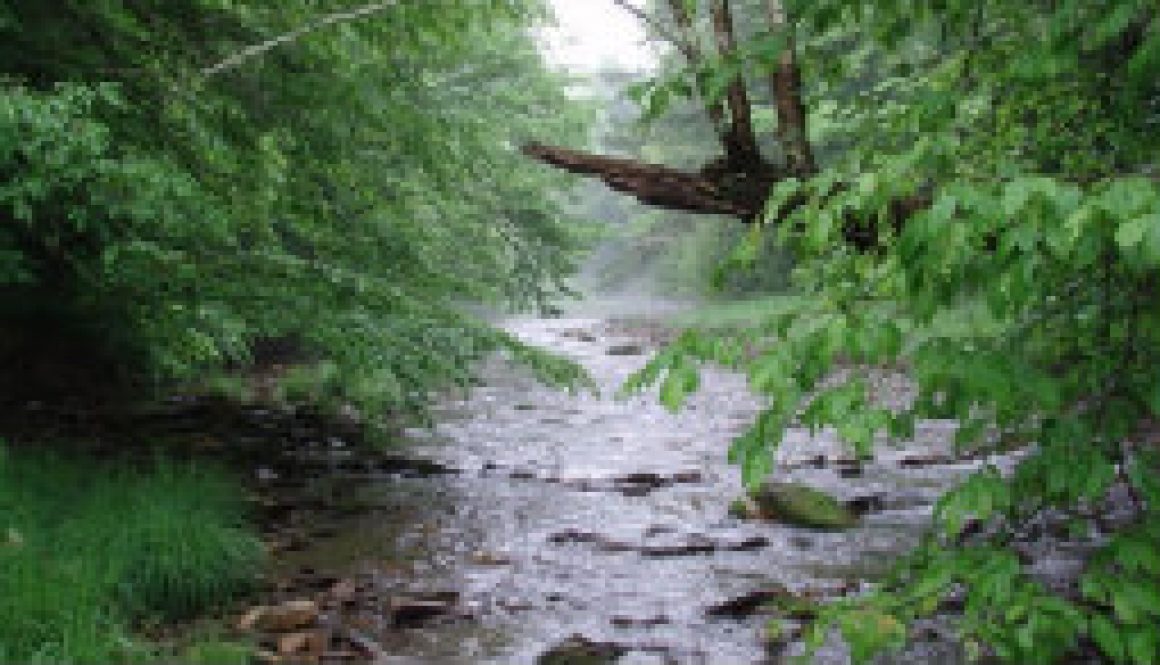
Floating the North Fork in the mid-1960’s PART One of Five

In was early spring 1964 and I had just finished a 18 mile float trip on the Current River with a friend, Steve Klicke, who was 2 years older than me. He had a wealth of river experience and was excellent at canoeing on rivers. I also admired his knowledge of the outdoors and his ability with a fishing rod. His family was from the Big Piney watershed, where they had a farm. The purpose was to get ready for the Current River tandem races in May. I met several people at the event on that day, that connected me to Oz Hawksley, who, at the time, was putting together Missouri Ozark Waterways, a publication that would map the Missouri Ozark Streams. I received an assignment prior to my first year of college. Map, chart, and explore, the North Fork or the White River and the Bryant Creek, during June and July 1965.
I agreed and begin to excitedly prepare for an June departure. My parents were nervous about all the things that could go wrong on a float that long. I grew up at the junction of the Meramec River and Huzzah Creek and they were all to familiar with flash floods, strainers (log jams that the river flows through that can easily trap you or your boat), venomous snakes, weather, heat exhaustion, etc., but in the end, it was their knowledge of these things that gave them the courage to let me go; in other words, I had already experienced all of that too.
The Ozarks of Missouri and Arkansas was a different place the early 1960’s than it is today. The rural way of life had not yet be sliced away. Small farms were marginally profitable, people were, almost always, friendly and honest and a little suspicious. There were still general stores in almost every community, where you could procure the goods you needed, and working farms still dotted the river valleys. The drive to the North Fork from St. Louis also took about 2-3 hours longer in 1964-1965 than it does today.
Monday June 15th, 1964
Our plan was to leave St. Louis Monday June 15th early in the morning and spend the day getting to the the takeout point; the Tecumseh bridge over Norfork Lake, leaving Steve’s car there, then driving back up to the Highway HH bridge (Highway 76 today). We had permission to camp in a large hayfield just downstream from the bridge. By 7:00 PM we had our tent pitched; and left our gear packed up and the canoe still on top of my 1959 Buick, Steve’s car was left at Tecumseh by the bridge. Our canoe was an Old Town Guide special order at 17′ (the normal was 16′). I suspect they used a modified OTCA mold with less upsweep in the ends and no keel. My brother and I bought it from the Old Town Canoe Company in 1964 for 388.00. At the time that was my entire savings. Even though a Grumman Aluminum canoe would have cost us almost $205 less, it did not want one. The Old Town was beautiful and made with the most perfect white cedar ribs and planked with red cedar; and had a gorgeous canvas covering of green and have cane woven seats. We also had 3 fairly new, beautifully made, Old Town beavertail paddles and a canvas patch kit.
The trip from St. Louis to the lake and back up to the put in, point took 14 hours total. We ran through 2 heavy thundershowers before arriving at the camping spot. On the way back we stopped at the Crossroads Store (still there but closed and across the gravel road from the original store) as of May 2009 (45 years later). We bought enough food and ice for at least 3-4 days sand carefully packed it in a cooler and dry-box. Food in those days consisted of a few steaks, eggs, bacon, lunch meat, bread, lots of tomatoes, potatoes, beans, a head of lettuce, and onion, and a large jar of mayonnaise, matches, and a small can of crisco in case we were able to string some large goggle-eye. Even back then, neither of us had the heart to do anything but release smallmouth bass we caught, carefully unharmed back into the river. After the 3-4 day period we were not sure what we were going to do about food. Our expectation was to spend about 2 weeks on the North Fork; mapping, charting, and writing. Additionally we had a one year old canoe tent from Sears, not light, not convenient, but we figured it would keep us and our supplies dry. We carried onboard a fly-rod, a F.E. Thomas Special, 8′ long and we took along with it a D and E weight, double tapered lines; and a box full of leaders, spinners, and streamers and a jar of pork rind fly-strip and of course a stringer.
In the spring and early summer of 1965 the area farmers enjoyed more than usual amounts of rain, which left the North Fork, in very nice floating condition into June, even as far up in the headwaters as we were. In fact, a decision was made by Steve K and I that evening, to go 5 miles further up and put in above Highway HH. A local farmer was to drive us up 5.5 miles (halfway back to Cabool) and put us in early the next morning, allowing us to float back to our parked car during Day One. We quickly found some dry firewood, cooked a steak and beans, eat and cleaned up. Steve K had a couple of cold Budweisers in the cooler that he taken from his Dad’s refrigerator. But in the end, neither of us had a church-key, so they were left alone this evening. As darkness began to fall in the valley, we safely stored all our highway maps, arial photography taken the summer before, and 1:62,500 contour maps away; and climbed into out sleeping bags with a hanging flashlight, which allowed us to read and plan for morning. It was not hard to fall asleep that night and I still remember the vociferous whippoorwills; dozens of them singing right outside our tent until nearly midnight. I was awakened only once by a barred owl and finally the whippoorwills again at dawns first light. I do not think Steve K moved once all night.




Debated whether to Post this or not (Pygmy Rattler)

Sistrurus miliarius streckeri
Local Name: ground rattler
This is one of the smallest species of rattlesnakes in North America. General color is light grayish-brown, with a row of small, dark brown spots on the back and similar spots on each side. Most specimens also have a rust-colored stripe down the back. The belly is usually gray. The pygmy rattlesnake has a thin tail and a tiny rattle. Length averages from 15 to 20 inches (38-51 cm). This species lives under rocks on cedar glades and is so secretive that few people encounter it. The sound of the vibrating rattle is a faint buzz like the sound of a grasshopper. Food includes small lizards, snakes, frogs and mice. Although the bite of this species is not fatal, a bite victim should seek immediate medical attention. The pygmy rattlesnake should be respected and left alone.
Missouri Distribution: Counties bordering Arkansas and the eastern Missouri Ozarks.

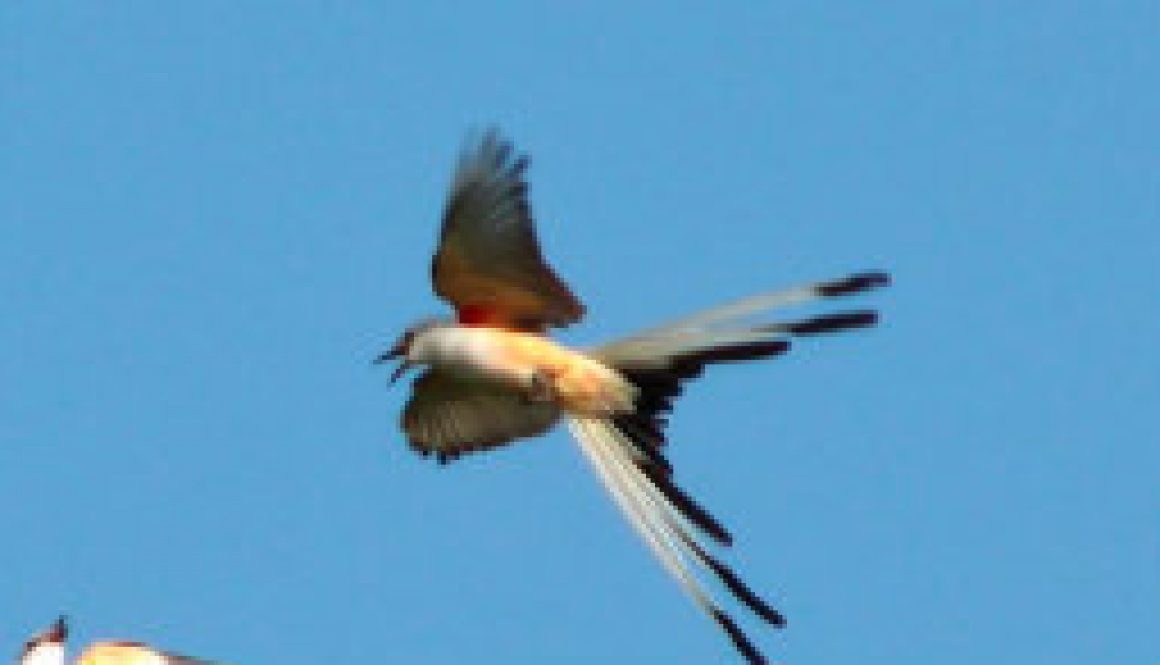
Scissor Tail Flycatcher
Click on image to enlarge
This May 19th, I came across two pairs of Scissor-tail Flycatchers. One pair about one mile south of Highway 181 at Crossroads and the second on the entrance field to River of Life Farm on the North Fork River. Both pairs were actively foraging for insects. Both pairs shown above and both pairs where using black cherry trees as landing bases.


